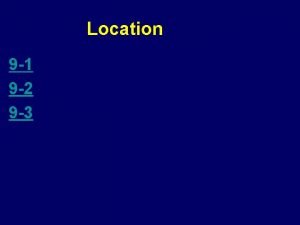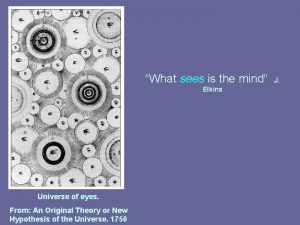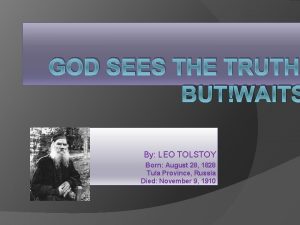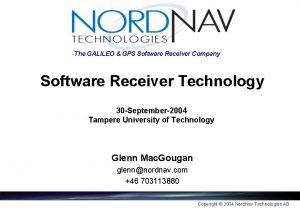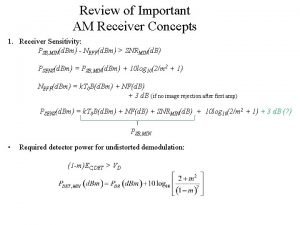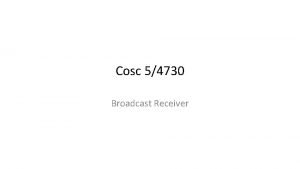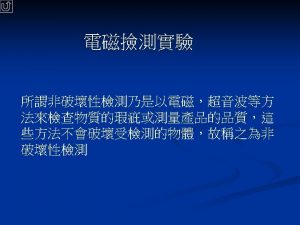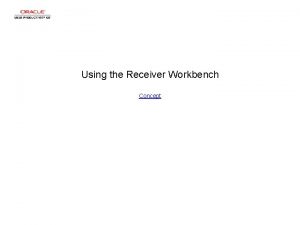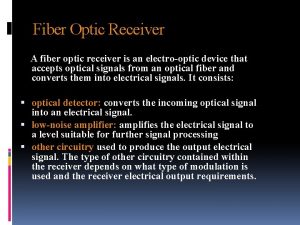What a Receiver Really Sees Receiver 1 Receiver











- Slides: 11

What a Receiver Really “Sees” Receiver #1 Receiver #2 Receiver #3 (true code phase) (estimated code phase based on one sample pair) A receiver generally has no information about the complete structure of the underlying peak -- only the values of its correlator samples. (Here, all three receivers’ correlator pairs make the same code phase estimate. ) 1

Differential Error What happens when the peak is distorted? (differential error due to distorted peak) (reference) (user) • Disagreement in code phase estimate between reference (ground station) and roving user is mapped onto a position error as a function of satellite geometry. Errors common to all SVs are mapped onto user clock error and corrected. 2

A Troublesome Example Given one or more monitors, what errors can get through undetected? (differential error) (ground reference) (aircraft) (ground monitor) but • To the ground, this badly distorted peak is indistinguishable from the nominal correlation peak shown on the earlier slide! 3

Generalized Fault Model • In general, a distorted GPS signal can be written as the sum of the nominal signal and a distortion term: • Starting with this model, we can derive an explicit worst-case waveform, , as a function of the system parameters: – – Number of monitor pairs and their spacings, Ground filter bandwidth and shape, Aircraft spacing, Aircraft filter bandwidth and shape, 4

Generalized Model: First Principles A single correlator sample and its frequency-domain equivalent 5

Generalized Model: Correlator Pair Late E L Early 6

Generalized Model: Basic LAAS (M=0) Ground processing Aircraft processing • The most evil waveform for M=0, , maximizes matched to the overall transfer function. and is • We can find the explicit form of using Gram-Schmidt orthogonalization and the Schwartz inequality. 7

Generalized Model: Full LAAS (M 1) SQM Algorithms (Algebraic functions of monitor inputs) Ground processing Aircraft processing 8

The Most Evil Waveform (1) The most evil waveform for M monitors, JM , lies in the null space of and maximizes. We can construct such a function using the Schwartz inequality and Gram-Schmidt orthogonalization. For example, the M=2 case is: With and 9

ICAO Model: Application (2) • This is almost periodic in Tchip: 0 Tc 2 Tc 3 Tc 4 Tc n. Tc • Compute the Fourier Series expansion starting with the fundamental frequency and scaling the resulting coefficients by the factor • This gives us an explicit relationship between and the amplitude of spectral spikes at (C/A nulls). 10

Synchronous Sampling (1) … First sample in epoch Start of epoch 1 First sample in epoch Start of epoch N • Uncorrected errors (Doppler, LO, ADC clock) lead to sample “drift” with respect to underlying features – 47. 5 MHz, 250 msec, 2 k. Hz Doppler (uncompensated) Accumulated error 15. 08 samples 0. 32 chips • Tight control of timebase required to avoid this error. 11
 Suzie sees bob rotating clockwise
Suzie sees bob rotating clockwise Who is the antagonist in the open window
Who is the antagonist in the open window Describe the chimera in percy jackson
Describe the chimera in percy jackson Kelly elkins nudes
Kelly elkins nudes God sees everything
God sees everything The ranger and the camper sees the bear
The ranger and the camper sees the bear The first element the eye sees; the focal point
The first element the eye sees; the focal point What condition threatens peeta's life?
What condition threatens peeta's life? Every time jarrad opens his cigarette case
Every time jarrad opens his cigarette case God sees the truth but waits resolution
God sees the truth but waits resolution Sees the celestial
Sees the celestial Macbeth study guide questions act 1
Macbeth study guide questions act 1
